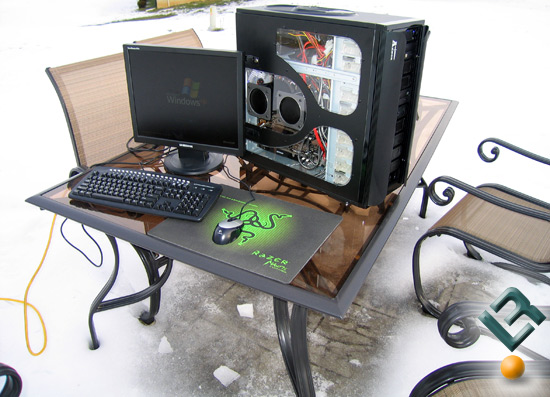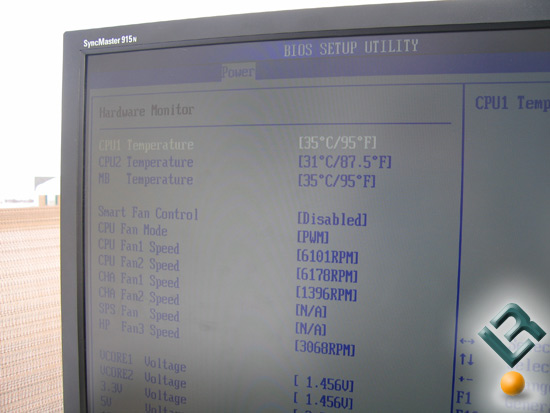Overclocking AMD’s Quad FX Platform – Hit or Miss?
My Overclock Brings QuadFX to the Yard
Although it is far from orthodox and practical I took the system outside and onto the patio for the rest of the time I spent overclocking it. St. Louis just had a huge ice storm and with about 3 inches of clear ice on the patio and plenty of snow I figured the nice below freezing temperatures would be the best way to cool AMD’s Quad FX platform.

Believe it or not I couldn’t move any of the chairs or the table because they were frozen in several inches of ice, but I managed to get the system up and running. Other than some funny looks from a couple neighbors looking on the plan worked like a charm.

At stock voltages before I was hitting 46C/47C and now that the system is outside in the snow and ice the CPU temperatures dropped to 35C/31C, which is an 11C or 16C drop depending on the processor. These temperatures should be just as good as any mainstream water cooling solution, so back to the overclocking!
I wish I had some screen shots or killer performance numbers for you, but none are to be had. Even though the CPU temperatures outside are night and day better it didn’t help out overclocking one bit. We tried getting the system to post at anything higher than 215MHz and it couldn’t do it with stability. It looks like 3.2GHz is the most we are going to get out of this system!
At first I was upset when the BIOS on the ASUS L1N64-SLI WS Motherboard didn’t allow for higher voltage options on the processors, but it’s clear that when the system was set to 1.45V that it would break 56C, the maximum CPU temperature, at load as it was sitting in the BIOS at 53C. For enthusiasts that like to overclock, I feel it’s safe to say that a pair of FX-74 processors and the ASUS L1N64-SLI WS motherboard are pretty uneventful overclockers. With that said, a pair of FX-70 processors might be very good overclockers since they come clocked at 2.6GHz and are also fully unlocked. If the FX-70’s can hit 3.2GHz then those parts would be a heck of a buy for 9 and should be able to hang close to Intel’s quad-core single processor offerings.
In the mean time it would be nice to see NVIDIA update their nTune software to be able to monitor the temperatures on this board. NVIDIA has told me that ASUS doesn’t have the right ‘hooks’ setup in the BIOS for them to get nTune to work, so they are unable to update it. At the same time ASUS’s PC Probe software also doesn’t work, so both ASUS and NVIDIA have no utilities available to monitor the CPU temperatures. I don’t care who is to blame, but someone needs to come up with a fix and get this utility published as it is needed. If I spent thousands for one of these systems and couldn’t monitor my temperatures, I’d be pretty upset.
I’m going to go warm up as I still can’t feel my fingers from being outside for so long!

Comments are closed.